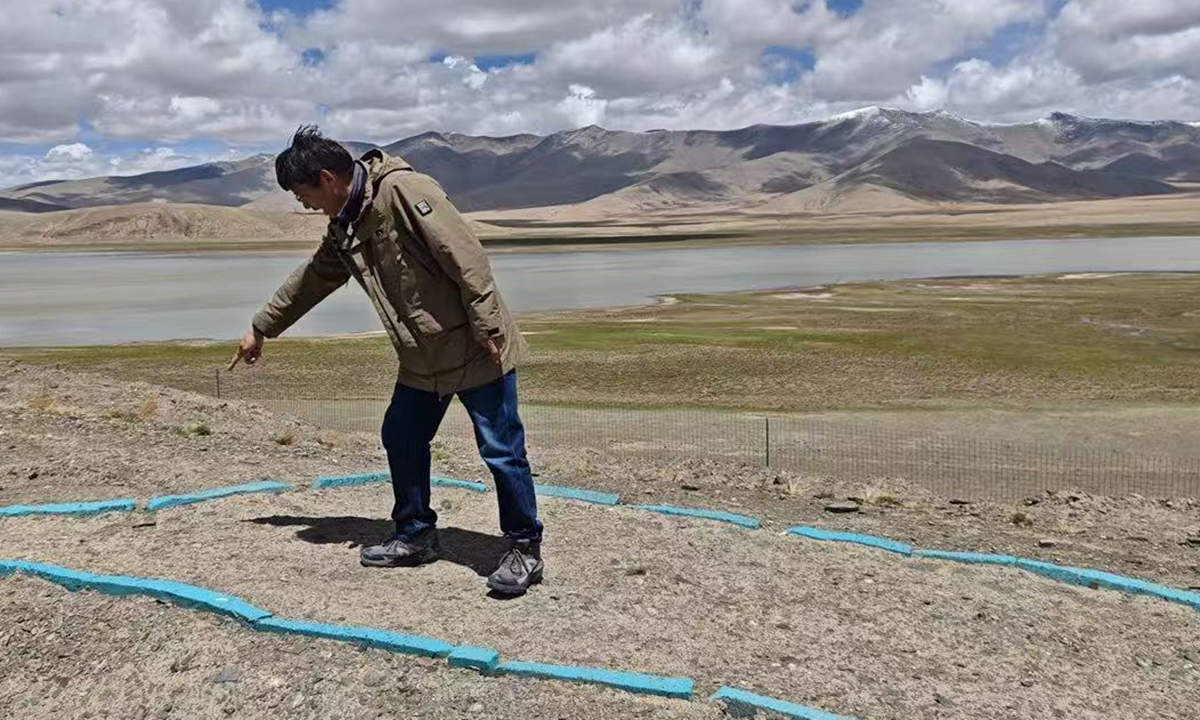
Shargan Wangdue, head of the Mabu Tsho site archaeological project, introduces the Mabu Tsho site in Kangmar County, Xigaze City, Southwest China's Xizang Autonomous Region on May 22, 2025. Photo: Chen Xi/GT
The reflection of snow-capped peaks ripples on the surface of Mabu Tsho Lake in Southwest China's Xizang Autonomous Region. Nestled within the hills around the lake was the renowned Mabu Tsho site that was inscribed as one of the top 10 national archaeological discoveries of 2024.
Following Shargan Wangdue, deputy head of the Institute for Cultural Relic Conservation of the Xizang Autonomous Region and head of the Mabu Tsho site archaeological project, we began the arduous climb up the slopes beside the lake.
The site, though backfilled, retains its original appearance, a hidden gem waiting to reveal its secrets. Close to the borders with India and Bhutan, the Mabu Tsho site is perched on the northern flank of the central Himalayas at an altitude ranging from 4,410 to 4,430 meters.
The site stands out due to four remarkable features: its high altitude, early dating, complete chronological sequence, and rich historical value.
"This discovery marks a significant milestone in Xizang archaeology, and is of irreplaceable importance in understanding human adaptation and evolution on the plateau, both in Xizang and globally," Shargan Wangdue told the Global Times.
The cultural features of the second and third phases of the Mabu Tsho site represent a new cultural type, aptly named the "Mabu Tsho Culture."
It is the highest-altitude and earliest Neolithic site discovered in the hinterland of the Qinghai-Xizang Plateau, dating back approximately 4,800 to 3,000 years, according to Shargan Wangdue.
Discovered burial practices are diverse, including stone coffin tombs, vertical pit earth tombs, and stone chamber tombs, with burial customs such as prone extended burials and secondary reburials.Notably, "stacked burials" were discovered in the second-phase tombs, a first in the plateau tomb archaeology. In the third-phase tombs, higher-specification enclosed stone chamber tombs and large vertical pit earth tombs with compartments were unearthed, yielding the earliest bronze chain rings and talc beads in Xizang.
"We also found the earliest mound tomb in Xizang in the third-phase tombs, pushing back the understanding of mound tombs from the Tubo period of the early Tang Dynasty (618-907) to prehistoric times," Shargan Wangdue notes.
"The increasing complexity of tomb forms suggests the emergence of social stratification within the plateau."
However, he pointed out that whether the emergence of high-specification mound tombs signals a continuation of this cultural lineage that influenced the Tubo civilization remains to be further explored.
In the fourth phase, the settlement layout underwent significant changes, with the appearance of the earliest large stone structures in Xizang.
"In the sacrificial pits of the stone structures, a sheep's head was placed on red sandy soil. In the camp area, not only were cooking stoves found, but also a large number of bird eggshells were left behind after consumption," Shargan Wangdue describes.
Power of scientific archaeologyAs one stands at the site, questions arise: When did humans first set foot on the plateau, and how did they adapt to this harsh environment?
Shargan Wangdue jokes that the day of the visit is lucky, as on normal archaeological days, one can experience all four seasons in a single day.
Despite the harsh high altitude conditions, lack of oxygen, and strong winds, beneath this unforgiving land lies a trove of treasures that bear witness to thousands of years of human civilization.
Scientific archaeology has played a crucial role in piecing together the lives of the ancient people of Mabu Tsho. Through interdisciplinary techniques such as ancient DNA analysis, pottery residue analysis, physical anthropology, and archaeology of animals and plants, the team has recreated a vivid picture of the ancient people's life by the lake.
Reconstruction of the ancient site's geomorphic background shows that the ancient lake covered an area of over 100 square kilometers 4,000 years ago, 11 times its current size.
The stable lake ecosystem supported abundant fishery resources, and the Mabu Tsho people ingeniously used the bones of cormorants and other water birds to make fish traps.
At that time, the lake shore was lush with grass, and the climate was humid, providing a more habitable environment for humans.
Professor Yang Xiaoyan's team from the College of Earth and Environmental Sciences at Lanzhou University, through the analysis of animal remains' seasonality, points out that the early inhabitants of Mabu Tsho engaged in fishing and hunting by the lake throughout the year.
Ancient DNA research by the team led by Fu Qiaomei from the Chinese Academy of Sciences has further unraveled the evolutionary code of the Mabu Tsho population.
The individuals unearthed from the early Mabu Tsho remains, dating back 4,400 to 4,000 years, already exhibit genetic characteristics consistent with those of the later southern plateau population.
This indicates that the southern plateau population with local genetic characteristics was widely distributed along the Yarlung Zangbo River basin during this period.
Some individuals carry a small amount of genetic markers from low-altitude populations in northern East Asia, suggesting complex genetic interactions between the early southern plateau population and the outside world.
"The topics of Neolithization, human migration, and cultural exchange on the Qinghai-Xizang Plateau are hotly debated in the international academic community. The archaeological discoveries at the Mabu Tsho site are sure to excite archaeologists worldwide," he said.




